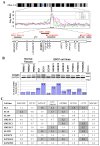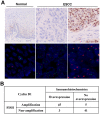Genome-wide screening for genetic alterations in esophageal cancer by aCGH identifies 11q13 amplification oncogenes associated with nodal metastasis
- PMID: 22761904
- PMCID: PMC3382571
- DOI: 10.1371/journal.pone.0039797
Genome-wide screening for genetic alterations in esophageal cancer by aCGH identifies 11q13 amplification oncogenes associated with nodal metastasis
Abstract
Background: Esophageal squamous cell carcinoma (ESCC) is highly prevalent in China and other Asian countries, as a major cause of cancer-related mortality. ESCC displays complex chromosomal abnormalities, including multiple structural and numerical aberrations. Chromosomal abnormalities, such as recurrent amplifications and homozygous deletions, directly contribute to tumorigenesis through altering the expression of key oncogenes and tumor suppressor genes.
Methodology/principle findings: To understand the role of genetic alterations in ESCC pathogenesis and identify critical amplification/deletion targets, we performed genome-wide 1-Mb array comparative genomic hybridization (aCGH) analysis for 10 commonly used ESCC cell lines. Recurrent chromosomal gains were frequently detected on 3q26-27, 5p15-14, 8p12, 8p22-24, 11q13, 13q21-31, 18p11 and 20q11-13, with frequent losses also found on 8p23-22, 11q22, 14q32 and 18q11-23. Gain of 11q13.3-13.4 was the most frequent alteration in ESCC. Within this region, CCND1 oncogene was identified with high level of amplification and overexpression in ESCC, while FGF19 and SHANK2 was also remarkably over-expressed. Moreover, a high concordance (91.5%) of gene amplification and protein overexpression of CCND1 was observed in primary ESCC tumors. CCND1 amplification/overexpression was also significantly correlated with the lymph node metastasis of ESCC.
Conclusion: These findings suggest that genomic gain of 11q13 is the major mechanism contributing to the amplification. Novel oncogenes identified within the 11q13 amplicon including FGF19 and SHANK2 may play important roles in ESCC tumorigenesis.
Conflict of interest statement
Figures





References
-
- Parkin DM, Pisani P, Ferlay J. Estimates of the worldwide incidence of eighteen major cancers in 1985. Int J Cancer. 1993;19:594–606. - PubMed
-
- Pera M, Manterola C, Vidal O, Grande L. Epidemiology of esophageal adenocarcinoma. J Surg Oncol. 2005;92:151–159. - PubMed
-
- Lambert R, Hainaut P. The multidisciplinary management of gastrointestinal cancer Epidemiology of oesophagogastric cancer. Best Pract Res Clin Gastroenterol. 2007;21:921–945. - PubMed
-
- Luo ML, Shen XM, Zhang Y, Wei F, Xu X, et al. Amplification and overexpression of CTTN (EMS1) contribute to the metastasis of esophageal squamous cell carcinoma by promoting cell migration and anoikis resistance. Cancer Res. 2006;66:11690–11699. - PubMed
Publication types
MeSH terms
Substances
LinkOut - more resources
Full Text Sources
Other Literature Sources
Medical
Research Materials
Miscellaneous

